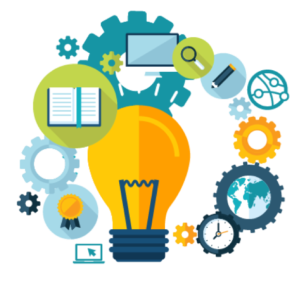Flipped Classroom Resources
 What is it?
What is it?
Flipping the classroom is a common strategy to provide students with content prior to a class session, whether held virtually or face to face, in order to allow for more learning activities and student engagement during the classes. More information can be found in the Atlas ABE article, Re-Imagining Instruction Part 2: Flipping the Classroom.
What are the benefits?
-
Allows instructors to utilize class sessions for learning activities and application of instructor explanation.
-
Allows learners the opportunity to review instructor explanations during their own time and at their own pace.
-
Allows the instructor to differentiate their explanations according to proficiency level, learning styles, technology access, etc.
-
Provides more time during class sessions for student collaboration and interaction.
-
Provides more opportunities for student engagement and community building during class sessions which will assist with learner persistence.
What are the drawbacks?
-
Because the learning activities during the class sessions are connected to the instructor explanations, if learners do not complete the asynchronous work, it can be difficult to engage learners during the synchronous session.
-
Instructors may run into a situation where some learners complete the asynchronous work while others do not which means learners will not be on the same page when completing the interactive learning activities.
-
Learners may need modeling and time to develop the time management and independent learning skills needed to effectively participate in the flipped classroom.
Resources:
-
Ready to Flip: Three Ways to Hold Students Accountable for Pre-Class Work: Article that supplies good strategies to determine student engagement and motivating learners to complete pre-work.
-
How do we get students to complete pre-class work?: Article that provides theory to support creating stimulating pre-work enhancing student motivation.
-
Five Ways to Motivate Unprepared Students in the Flipped Classroom: Article that provides strategies for modeling pre-work and supporting less motivated students.
-
10 Strategies to Encourage Students to Actually DO the Pre-Class Work in Flipped & Active Learning Classrooms: Resource that provides a more indepth process for motivating students to participate in the pre-work for a flipped classroom.
-
4 Tools for a Flipped Classroom: Article that provides suggested tech tools for creating a flipped classroom. Most of these tools and others are highlighted in the Instructional Tools section of this website.
-
Making Your Flipped Classroom More Human: Article that provides strategies for engaging and retaining learners using a flipped classroom.
-
EdWeek report, Educators Evaluate “Flipped Classrooms”: Resource that provides an evaluation of the flipped classroom as well as tips for successful implementation of the flipped classroom.